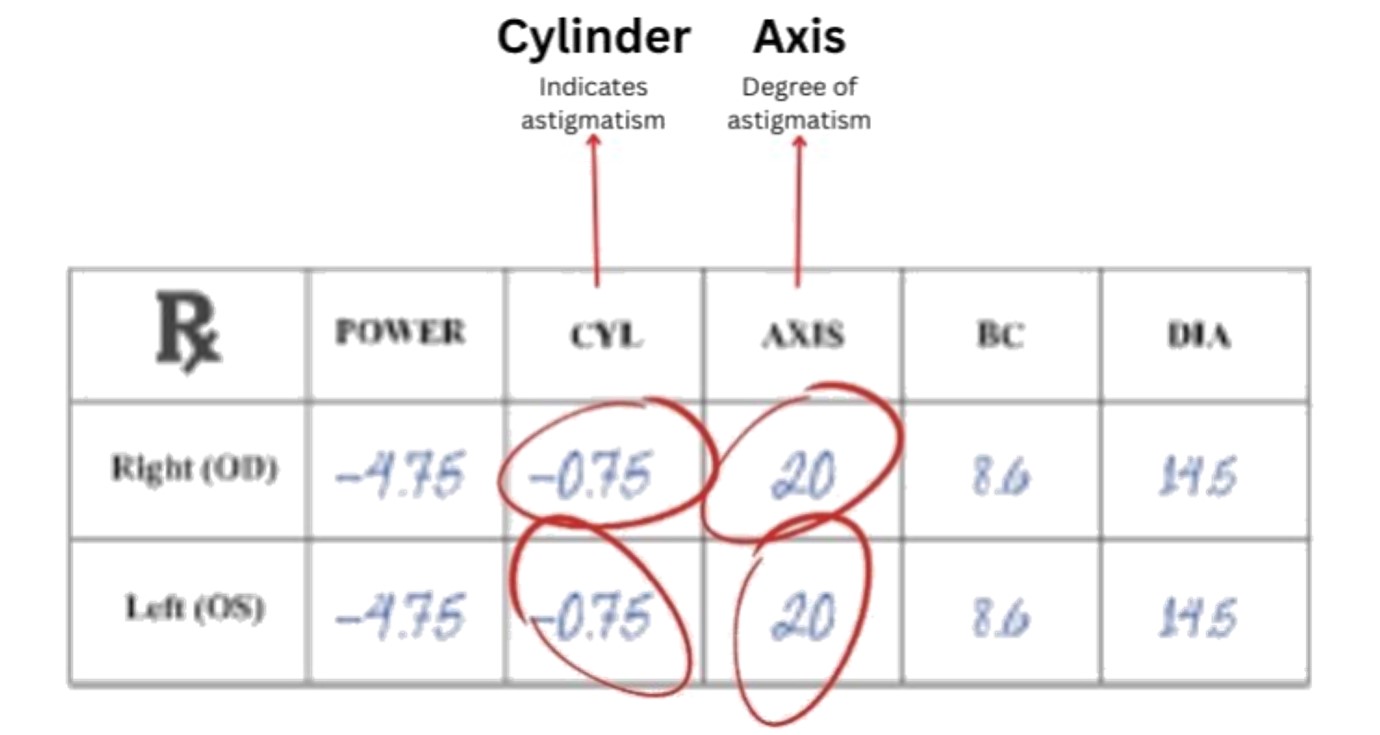
Astigmatism is a common refractive error that causes blurred vision due to an irregularly shaped cornea or lens.
If you have astigmatism and you’re looking for a more permanent solution to blurry vision, you may be wondering:
- “Can I have Laser Eye Surgery for astigmatism?”
- “Can Laser Eye Surgery treat severe astigmatism?”
- “What sort of treatment outcomes can I expect following the procedure?”
In this article, we’ll discuss:
- What exactly is astigmatism (and its various sources and forms)
- How Laser Eye Surgery is used to correct astigmatism
- The latest and most effective treatment options
Here’s everything you need to know.
What Is Astigmatism?
Astigmatism is a condition where the eye’s cornea or lens has an irregular shape, causing light to focus on multiple points in the eye rather than a single point. This results in blurred or distorted vision at all distances.
It’s one of the most common diagnoses and is very manageable:
14%of under-15s |
30%of all people |
67%of over-65s |
*Based on a study of 2124 patients.
There are two main types:
- Corneal astigmatism: Distortion of the cornea (outer part of the eye).
- Lenticular astigmatism: Distortion in the lens (inside the front of the eye).
Astigmatism can also be classified based on its relationship with other refractive errors:
- Myopic astigmatism (nearsightedness)
- Hyperopic astigmatism (farsightedness).
- Mixed astigmatism (both near and farsightedness).
Common Symptoms Of Astigmatism
Although the brain accommodates for small distortions, significant astigmatism can cause:
- Blurred vision (up close and/or far away)
- Difficulty with night vision
- Eyestrain or irritation
- Frequent headaches
- Squinting
This is why regular screening and vision testing by an eyecare specialist is vital — so that they can quickly identify, treat and prevent problems from worsening.
What Does An Astigmatic Prescription Look Like?
An astigmatism prescription typically includes three components:
- Sphere (SPH): Indicates the lens power needed to correct nearsightedness or farsightedness
- Cylinder (CYL): Denotes the amount of astigmatism
- Axis: Specifies the direction of the astigmatism (measured in degrees)
It looks like this:
Treatment Options
There are several astigmatism treatment options available — here are their pros and cons:
Pros |
Cons |
|
Glasses |
· Generally inexpensive.
· Can be removed when not needed. · No need for ongoing maintenance or follow-up. |
· May be inconvenient or uncomfortable.
· Easily lost or broken. · Can fog up or be affected by weather conditions. |
Contact Lenses |
· Provides a more natural appearance.
· Can be worn during sports and other physical activity. · No need for ongoing maintenance or follow-up. |
· Risk infection without proper hygiene and care.
· Can inconvenience daily activities, such as face washing, showering etc. · May need frequent replacement. |
Laser Eye Surgery |
· Permanent or long-lasting correction.
· Quick and simple procedure. · Low risk of complications. |
· Expensive.
· Requires surgical procedure. · Needs follow-up appointment. · Some people may be unsuitable due to medical conditions or other factors. |
Ultimately, the best choice will depend on your specific needs, lifestyle, and preferences.
Laser Eye Surgery For Astigmatism
LASIK eye surgery for astigmatism has a very high success rate at AccuVision. It is an excellent procedure for most patients with astigmatism, and can be used to correct most types of astigmatism very effectively.
In fact, Mendoza et al. conducted research on the postoperative outcomes of LASIK in astigmatic patients.
The results, published in Investigative Ophthalmology & Visual Science, showed LASIK for astigmatism, even in severe cases, is often highly effective.
Can Severe Astigmatism Be Treated With Laser Eye Surgery?
You may have been told that you’re ineligible for Laser Eye Surgery due to:
- Your level of refractive error (too shortsighted or too farsighted).
- Source of your astigmatism — corneal, lenticular or both.
- Extent of your astigmatic distortion.
But this may not necessarily be true.
Our surgeons routinely treat complex astigmatisms — patients with even 6 Diopters of astigmatism can expect excellent long-term vision outcomes.
Book your consultation with us, and your clinician will discuss all your available options in detail to determine the best course of treatment.
4 Things To Consider Before You Get Laser Eye Surgery
To determine if eye surgery for astigmatism is suitable for you, consider the following factors:
1) Your overall health
You may be ineligible for Laser eye surgery. if you:
- Have underlying health conditions, such as autoimmune disorders and uncontrolled diabetes.
- Are pregnant, as pregnancy could affect the shape of your cornea.
- Have had previous eye surgery, as you’re at higher risk for complications.
Discuss these and any other potential risk factors with your clinician during the consultation.
2) The expertise of your surgeon
An experienced surgeon will have a thorough understanding of the techniques used in Laser eye surgery. They can identify and manage any vital decision making or complications that may arise during the procedure.
A skilled surgeon is crucial in ensuring the best possible outcome for your treatment.
3) Calibre of technology
Which is more important? The laser or the diagnostic equipment?
The laser makes precise, controlled changes in shape of your cornea — any inaccuracies or imprecisions could result in suboptimal outcomes or complications.
And diagnostics provide critical calculations necessary for your procedure.
So, it is impossible to have one without the other.
That’s why we place equal importance on both — and have worked with WaveFront to develop our diagnostic and therapeutic equipment to match our rigorous standards.
This is the best way to have precise control over every aspect of your treatment.
4) Cost of the procedure
Laser eye surgery cost may vary greatly depending on the procedure, the location and the surgeon.
But here are some other factors you should look for in your treatment:
- Comprehensive pre-surgical assessment so you get the best treatment plan for your individual needs.
- Experienced clinicians using cutting-edge equipment for advanced surgical precision.
- Extensive aftercare with detailed advice and follow-up to ensure the best long-term visual outcome.
FAQs
What is the success rate of LASIK surgery for astigmatism?
LASIK surgery has a high success rate for treating astigmatism, with most patients achieving 20/20 vision or better after the procedure.
Can astigmatism be cured permanently?
While Laser Eye Suergery astigmatism treatment can provide long-lasting results, it’s important to note that your eyes may change over time. Some patients may require enhancement procedures in the future.
What is the recovery time for laser eye surgery for astigmatism?
Most patients experience improved vision within 24 hours after surgery. Full recovery typically takes a few weeks to a few months.
Are contact lenses a good option for astigmatism?
Yes, contact lenses for astigmatism can be an effective treatment option. Toric lenses are specially designed to correct astigmatism and provide clear vision.
Conclusion
If you’re wondering “can astigmatism be corrected” or searching for “how to cure astigmatism permanently,” Laser eye surgery offers a promising solution.
While it may not be an astigmatism cure for everyone, most patients find significant improvement in their vision and quality of life after the procedure.
Consult with an eye care professional to determine the best astigmatism treatment for your unique situation.







